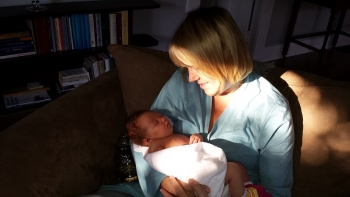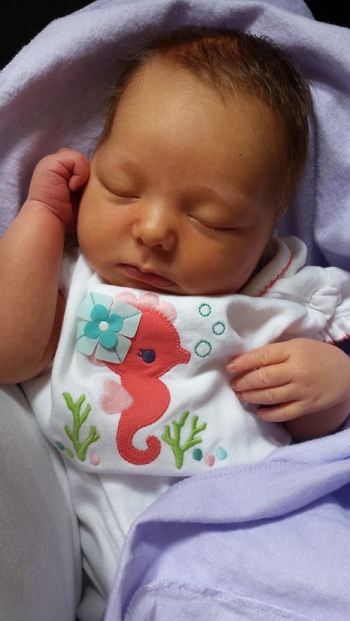 Heather with Adelaide at one week old
Heather with Adelaide at one week old Adelaide at one or two months
Adelaide at one or two monthsWhile my husband and I waited for the birth of our daughter nine months ago, I spent much of my pregnancy contemplating how I would incorporate my aspirations as a mother, nearly 20 years’ experience as a teacher, and my ongoing discipline as a Buddhist practitioner into my parenting style. I found myself reflecting on my university days at Naropa Institute, where I studied Contemplative Early Childhood Education. Over the course of my teaching career, I worked in many different cultures around the world where different styles and approaches were used and needed, but I always came back to the fundamental principle I learned at Naropa—that young children learn from who we are and what we do, and not from what we say. It is the inner being and mindset of their parents, teachers, and caregivers that they model. I think it was Carl Jung who said it best: “Children are educated by what the grown-up is and not by his talk.”
As someone who aspires to follow the path of the Buddha, I began to look more closely at my own “talk” and tried to be very honest with myself as to whether I was “walking the walk” or just “talking the talk,” because it seemed like the most basic place to begin to incorporate my hopes for motherhood and my training as an educator and meditator. I began to compose lists of my “credentials” as a practitioner to prove to myself that I was indeed “walking the walk.” Didn't I ordain in Burma, eat only two meals a day, sit doing shamatha (calm-abiding) meditation for eight to ten hours a day in scorching heat? Weren’t my legs contoured by a thin line of salt from evaporated sweat as if someone had traced their outline with chalk on my small, paper-thin vinyl mat at the end of each day? Didn't I follow my teacher around the globe listening to his teachings on Vajrayana Buddhism while trying my best to apply his every word, carrying his bags whenever the opportunity arose? Hadn't I retreated into the poisonous tick-, spider-, and leech-infested forests of Australia for three years to meditate? Surely all these retreats and experiences automatically meant that I was walking the walk?
Now, due to the incredibly sobering experience of growing another human being within me, a genuine courage arose and I was able to really look at my experiences. With a bit of embarrassment, I had to admit to myself that no, in fact all these experiences and attempts at “being a good Buddhist” did not automatically mean that I was actually walking the walk. And yet I have been on a spiritual journey, and it has enabled me begin to cultivate very specific tools that have helped me grow as a teacher of young children, as a wife, and as a community member. And now, I’m finding these same tools are invaluable to me as a new mother.
Meditation is a technique to open up to space, and within that space, all kinds of feelings, emotions, and thoughts arise. When meditating, the idea is to rest and relax into the arising without grasping, attaching, or pushing anything away. The meditator simply rests and allows everything to arise and dissipate while maintaining a sense of awareness of the physical space in which they are sitting. During labor, I found myself coming back again and again to that sense of simply resting, letting the waves of pain arise and fall. It was my first step in becoming a mother and in walking the walk. Maria Montessori, in her seminal work The Absorbent Mind, wrote about her discovery that education is a natural, spontaneous process which is not acquired by listening to instructions but through the way the child acts upon and engages with his or her environment. Education from a contemplative perspective is about allowing the child the freedom to explore at his or her own pace and inclination. During labor, while I was pushing, I had my first opportunity to apply these teachings. Near the final moments, just before my daughter’s head crowned, my doctor ask me to focus on her voice. I did, and at one point, when she said to wait, I could feel Adelaide moving her head through the birth canal herself. It was shocking to me—I hadn't expected to feel her moving like that. There she was, wiggling and moving, engaging with me and the environment, eager to come into the world. I felt that through mindfulness practice I had been able to stop at the crucial moment in labor to allow Adelaide the opportunity to explore at her own pace.
Since those first moments of her coming into the world, many of my Dharma friends have asked me to share some of my experiences as a new mother. There are so many little moments and details that have unfolded since her arrival that clear blue sky day in September that it is difficult to put those tiny treasures into words. Yet, in many ways, it is just those moments that are what it is to be a Buddhist mother. It is practice itself and the cultivation of mindfulness that have given me the opportunity to notice those moments I hold so dear. It is not only the grand moments: the first smile, the first coo, the first moment of sitting up unassisted, or even the first utterance of “Mama” that really express motherhood at its finest. Although those big firsts are very special, for me as a practitioner, it has been about the tiny, almost imperceptible unfolding of my daughter’s personality. Ideally, my mind is not split, thinking of the laundry or the dishes when I’m holding, nursing, or changing her. Or, more honestly, when my mind is split and my attention wavers between thoughts of what I have to do next and where I am at the moment, I can simply arrive within the moment and let go of the extraneous thoughts. It is such a gift to be able to notice when the mind has wandered and then to simply be present.
Now that I am a mother, I no longer have time for the long sadhana practice that I did before. Rather, I use the daily activities of motherhood as my anchor for mindfulness. For example, when I am changing Adelaide’s diaper I connect with my breath, and then take a moment to really look at her on the changing table, chat with her about what we are about to do, and talk her through the experience. I harness my mind to the task of bottom-cleaning and diaper-changing as if it were my breath and I was on my cushion. When I slow down within these ordinary moments, it becomes obvious that they are extraordinary gifts. As she lays on the table, we smile and converse and begin the slow process of getting to know each other. If I hadn’t been willing to be present and work at being present I would miss these little moments. This isn’t to say I am able to be present all the time—it is work to be present while changing diapers or nursing. It is the hardest, and yet most rewarding, work I have ever undertaken.
Now, in our daughter’s ninth month, my formal practice looks very different than it did ten months ago. I find that as I get into bed, taking just two minutes to sit upright and settle my mind with shamatha-vipashyana practice before sleeping is invaluable. I could not use diaper-changing as an object of mediation if I did not use formal practice as my ground. I don’t glide effortlessly through my days as a new mother as if I were floating along with rainbows all about me, mindful the whole time. Even before I sat down to write just now I was changing Adelaide’s diaper and thinking ahead to when I might have a moment to sit down and type—and realized I was putting her tights on backwards! It is exactly at moments like this that my mind snaps into the present and I have a tiny realization that says “aha, I’m here,” confirming that mindfulness is a constant awakening process and that motherhood provides an endless array of opportunities to be present in the moment! As our days unfold together, I realize that I don’t have to have a pre-set concept of what kind of parent I want to be for Adelaide; rather, I realize that by being present, I will naturally respond to each individual moment as best I can with the tool of spacious mindfulness. It is rarely perfect, but those imperfections and momentary wanderings into thoughtlessness are a gift, reminding me to be mindful and present again and again.
This is the first article in Heather’s new monthly column on “Buddhist Parenting” for Buddhistdoor.
See more
Montessori, Maria. (1949) 2009. The Absorbent Mind. Reprint, Thousand Oaks: BN Publishing.
















